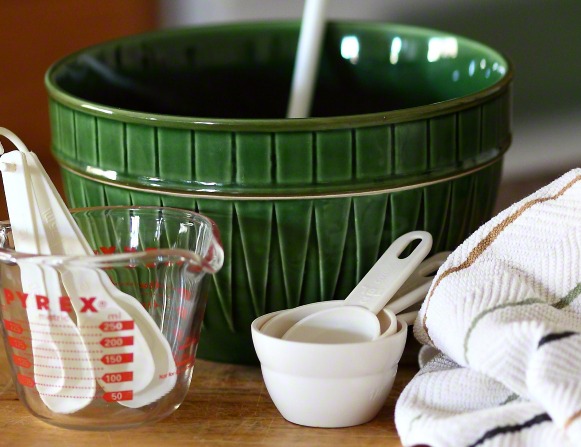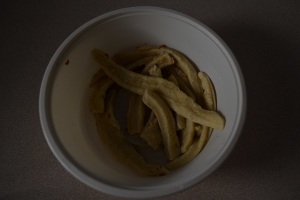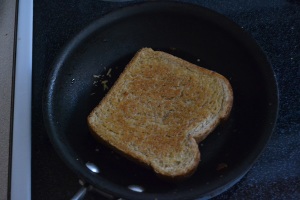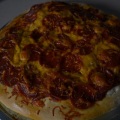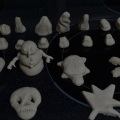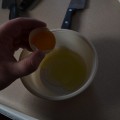I often get the feeling that people perceive cooking to be harder than it actual is. I imagine part of that is just not practicing, and not keeping track of what didn’t work and why. To that end, I am going to recommend several meals that can help you hone your cooking skills.
EQUIPMENT AND ESSENTIALS
Before getting to any recipes, there are some things that any good kitchen should have.
- A small saucepan; about the size of a roll of duct tape
- A large saucepan; about seven inches wide or so, and get one with a lid if possible.
- A frying pan; for your Tangled costume, and well, frying things.
- A pot, preferably with a strainer in the lid or as an attachment
- A large cookie sheet
- A cutting board
- A 9X12 pan
- A flat spatula; for flipping pancakes and the like
- A kitchen knife; though you can use a breadknife for a lot of the same things.
- A pizza cutter
- Measuring cups
- Measuring spoons
As well, there are ingredients that you will use often enough that it would be wise to buy them in bulk, if possible.
- Flour
- Sugar
- Brown sugar
- Vegetable oil
- Salt
- Butter
- Yeast
- Cinnamon
- Baking powder
- Baking soda
- Eggs
- Milk
BURNING WATER
Boiling water is one of the most common things you will do in a kitchen, so learn how to do it right. Put the pot or pan on your heater, and let the mind games begin. It’ll try to fake you out with little bubbles that stick around the bottom of the pan. This is actually oxygen that the cold water held that the hot water can’t. Then you get wiggly bubbles that don’t quite reach the surface of the water. That’s water vapor that condenses in the cooler water near the surface. It’s when the bubbles travel all the way to the surface that the water is actually boiling.
You may ask, why bother with reaching a full boil anyways? Tradition! More accurately, Transition! When water is boiling, it stays at a constant temperature. The water that gets hotter than the boiling point turns into vapor and flies away. This means you can cook things at a constant temperature, and thus have standardized cooking times.
NOODLES
Truly, there is no better topic to follow up boiling water with than noodles. I won’t dignify this with a recipe, but spaghetti is a pretty common dish to practice getting your noodles al dente. A lot of it is just checking a noodle from time to time as the mess sits in boiling water. There are all sorts of ways of checking for that “soft to the tooth” quality, but why make it complicated? Pluck out a noodle (letting it cool) and bite it. If you can feel a stiff/crunchiness in the core of the noodle, it’s not done.
While we are here, we can practice improvisational cooking. This recipe is only approximate; back in Ohio it worked fine, but in Utah it is giving me lip.
1 cup Flour
1 egg
A bit of vegetable oil
A tablespoon of water
Mix it all together, and you should get egg noodle dough. For whatever reason, when I last tried it, I had to use two eggs. Maybe Utah chickens are midgets. At any rate, you may find that when you mix it together, it is too dry and just forms lumps and leaves a lot of flour lying around, or it could also be really sticky and hard to deal with. If dry, add more water. If sticky, add more flour. Fair warning, you may have to use a hand to knead the dough together, and it will get covered in dough bits. Be extra careful when washing that hand, hot water may partially cook the dough and make you scratch it off.
It should look like this, when all is said and done: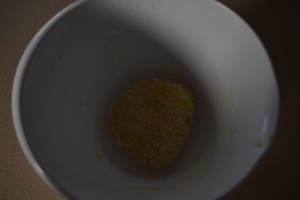
From there, you have some options. You can flatten it out a bit and microwave it and end up with a substantial hunk of starch, to which I recommend adding cheese, bacon, and maybe soy and tabasco sauce. For actual noodles, lightly flour a cutting board, and use a rolling pin to flatten the dough out. You may need to add flour to the top to keep it from sticking to the rolling pin. Once it is sufficiently thin, use a pizza cutter to cut long, narrow strips into the dough.
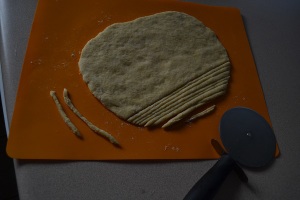 Toss those suckers into boiling water, and they’ll cook pretty quickly. Add bullion to that water, and you have something pretty similar to homemade ramen. The noodles in this next image are rather larger than what I would recommend; making a bunch of thin noodles will give you more flavor than fewer and thicker ones.
Toss those suckers into boiling water, and they’ll cook pretty quickly. Add bullion to that water, and you have something pretty similar to homemade ramen. The noodles in this next image are rather larger than what I would recommend; making a bunch of thin noodles will give you more flavor than fewer and thicker ones.
GRILLED CHEESE SANDWICH
This is pretty easy; butter one side of two pieces of bread, put some cheese in between, apply to frying pan. The practice comes from checking on how fried the bread is, and getting a semi-instinctual grasp of how long it takes. You could conceivably practice the same sense of timing with pancakes, but buttered bread is a bit more forgiving if over or undercooked. Just for reference, this is about how a nicely cooked side should look:
This is a good meal to experiment with adding ingredients. I personally like to put bacon bits in with the cheese, but there are many other options; meats, vegetables, spices, etc.
A goodly amount of cooking can only be understood in a non-verbal way, and meals like these are a good way of picking up an understanding of how food changes as you prepare it.
About Brandon Quist
Brandon is originally from Olmsted Falls, Ohio. He has studied both at Baldwin Wallace college and Brigham Young University, and is currently pursuing Chemical Engineering, among other things. He considers himself a jack of all trades, and a master of none. In his spare time, Brandon enjoys knitting, guitar, reading, origami, writing, and photography.

